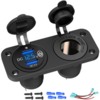.
OK, no one's mentioned this twist yet, so here goes.
The old Vintage Speedsters came up with a slightly better mousetrap for heat ducting. They routed the heat from the heater boxes into flexible 3" plastic hose that ran under the car, but just inside the rocker panels, and connected that to the usual vents in the front footwells. (They also connected small ducts up to the defroster vents, but you could probably skip that.)
This provides pretty good, uh, 'heat'. If you go to the trouble of putting the top up and side curtains in, it almost feels like a modern car inside — after a while.
With the top down, though, not so much.
Only you can decide if a little heat with the top down is worth bothering with. In the 50's and 40's, it might mean the difference between going out or not. Or, it might mean the difference between driving with a passenger or alone.
Here in sunny California, with (in most years) mild winters, it has greatly extended the usability of our car, and I wouldn't be without it. Ironically, we may use it most in summer. Then, to beat the mid-day heat, we often start a long trip in the wee hours, when it can be chillier than you'd guess for the first hour or so.
What will call for larger than standard heater boxes is the diameter of the exhaust headers, and most engines larger than stock will require that. Decent quality one-and-a-half inch boxes are not too exorbitant. Larger than that, and look out!
.






